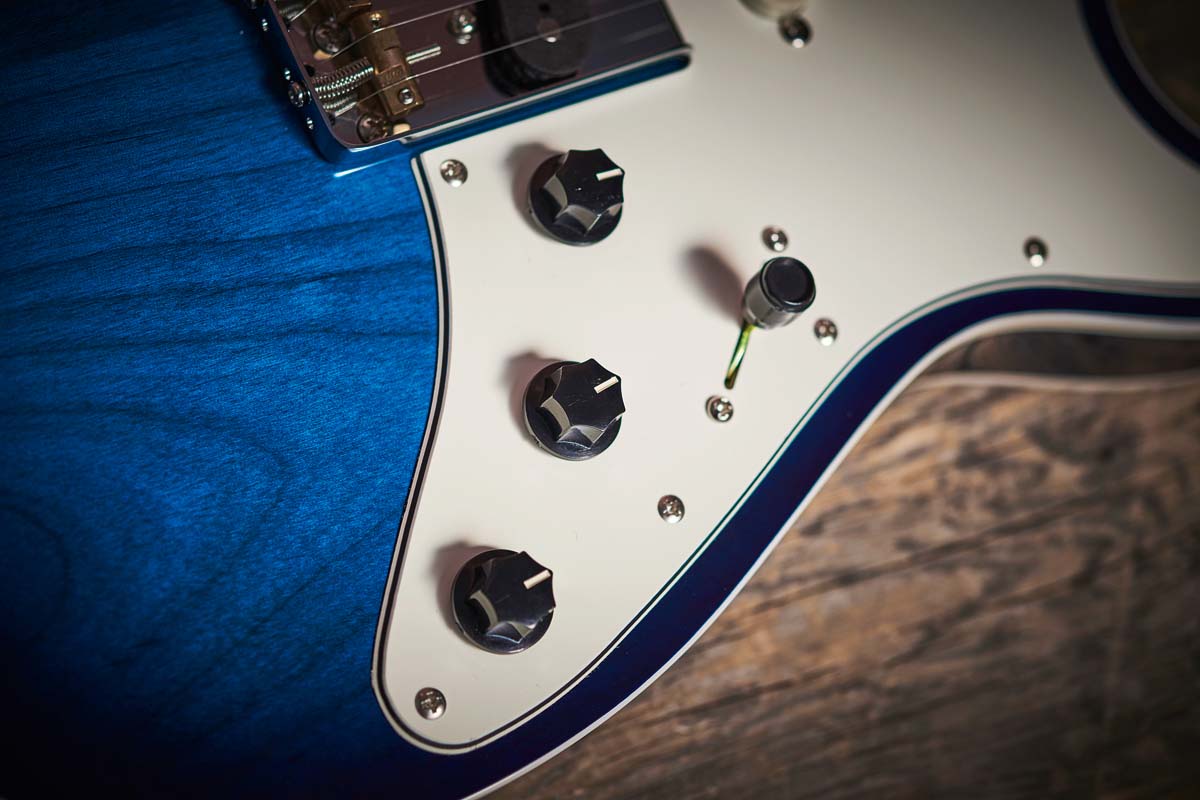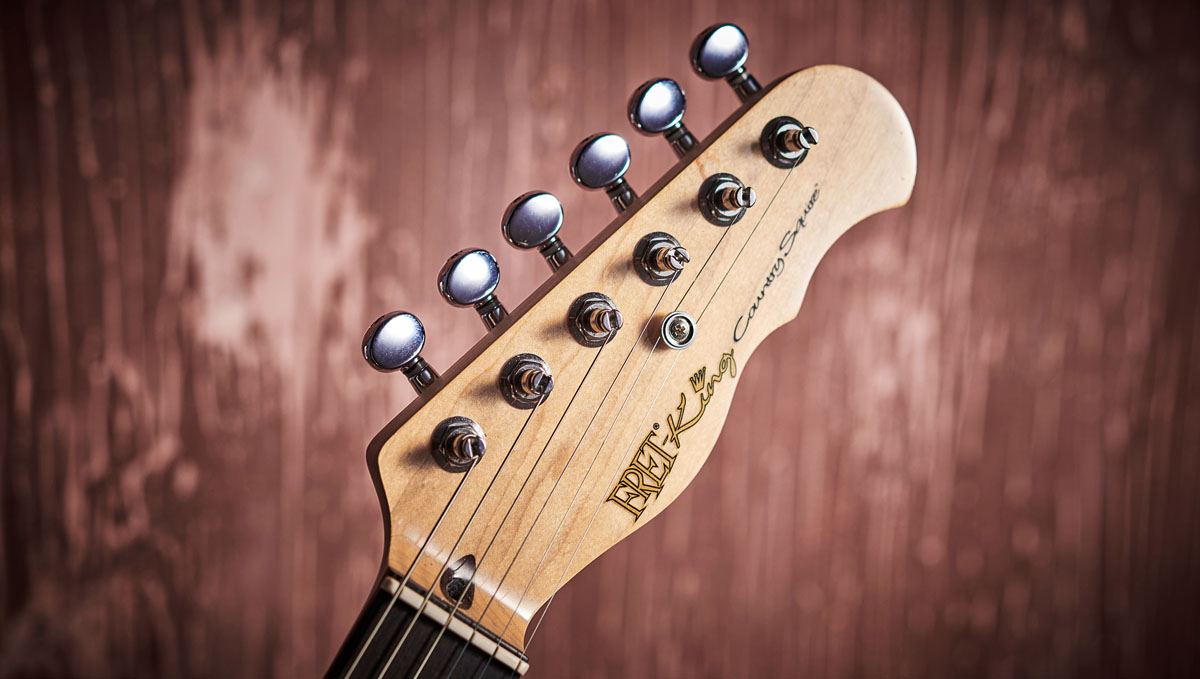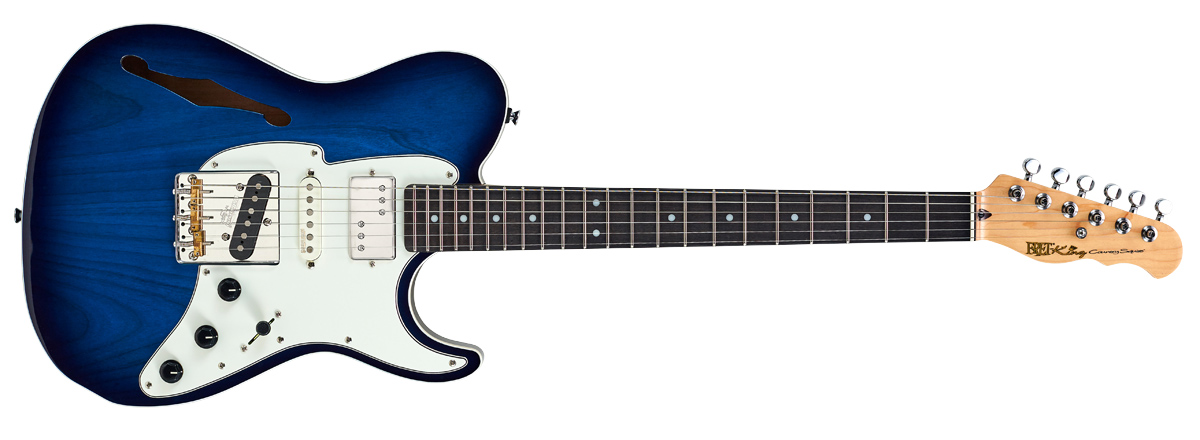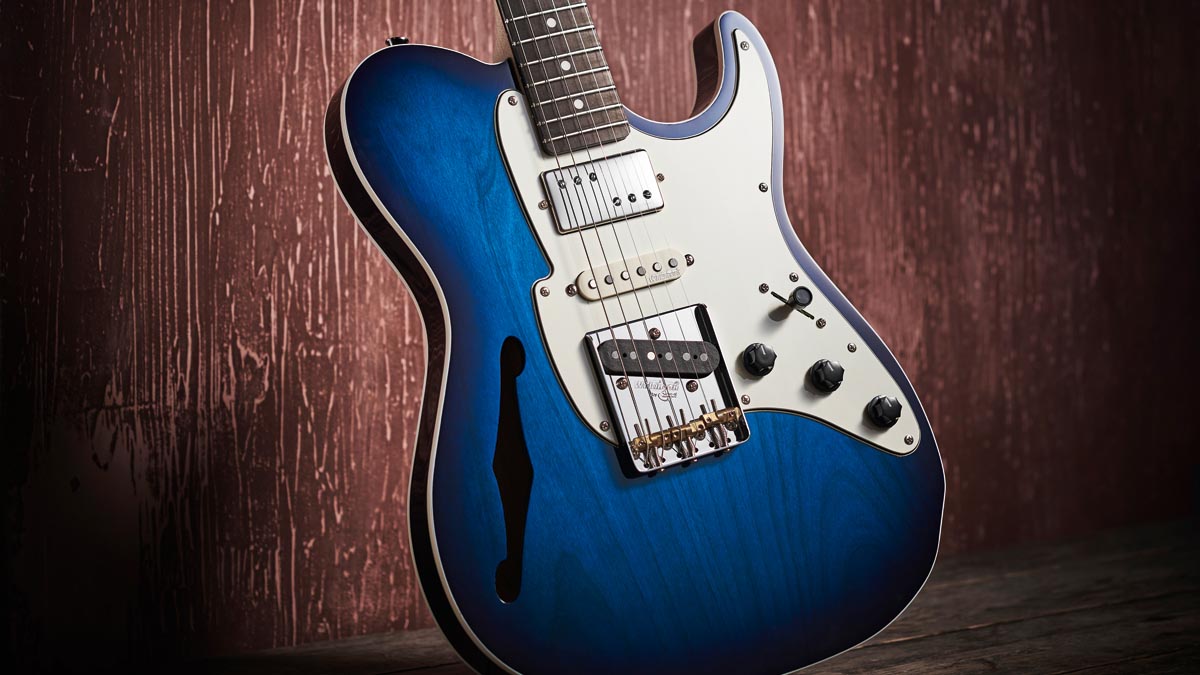Guitar World Verdict
A well-designed T-style with boundless potential for modding that underscores Fret-King's reputation for affordable quality.
Pros
- +
Typically tidy, well-designed and well-priced.
- +
Considerable sound potential.
- +
Heaps of features.
- +
Gigbag included.
Cons
- -
The Vari-coil control needs a better taper.
You can trust Guitar World
Exactly why Fret-King has never hit the big-time is beyond us. The company has consistently produced good guitars, and has always ticked the affordable box at its ‘Black Label’ level.
The brand parted company with its original owner and designer, Trev Wilkinson, in 2018, but there remains no shortage of guitars, now made in India. The current range is certainly expansive, covering numerous classics with the Strat-inspired Corona, the Eclat’s take on a Les Paul and, as here, the Tele-derived Country Squire.
Along the way, Fret-King has hooked hugely experienced artists such as Jerry Donahue, Geoff Whitehorn, John Verity, Danny Bryant, Gordon Giltrap, John Jorgenson, John Etheridge and Dave Colwell.
The Country Squire Semitone Special was introduced back in 2013 in a single Green Burst finish with an all-maple neck - a request from Scottish guitarist Ash Gupta to fill a hole left by a long-lost Fender.
We missed it back then, so with a recent announcement of a new Blue Burst version with ebony fingerboard, there’s an excuse to put it through its paces. In short, it’s a very tidy design with an ‘everything but the kitchen sink’ ethos, a sensible price and a decent gig bag. What gives?
- The best electric guitars for all styles, abilities and budgets
- Best electric guitars under $1,000: options for beginners and experts
Straight out of the gigbag, this is a very playable guitar… with a snappy, lively response and roomy unplugged projection
As you can see, the cleanly double edge-bound shape itself is a classy, stylized take on the Telecaster with a lightly offset base and a rounder shoulder that flows into a wider treble-size cutaway with a thinner horn. The basic spec info quotes the body as two-piece American alder, which we have no reason to doubt.
Peering through the single f-hole, the slightly rough-finished wood looks like alder, even though you’d be forgiven for thinking the front and back look a little more like ash under that translucent finish.

It’s not immediately clear how much of the body is air, either. Clearly, there’s a cavity under that f-hole, which appears to stop around the waist, although tapping that shoulder suggests another sealed cavity. It seems pretty solid behind the bridge, too, but tapping the body suggests we might have another sealed cavity below the actual control cavity.
Removing the scratchplate, there’s an open route from the tip of the bridge for the neck and middle pickups. One result of this airy build is its light weight at just 2.97kg (6.54lb).
The maple neck is a little different, too, in that it has a heel that slots into the body and extends slightly under the neck pickup, unlike a Fender and more like a PRS. It’s a stable join with zero movement, and the four screws holding neck to body sit in recessed washers. The headstock is noticeably different with its ‘W’ cutout on the treble side and a very steep fall from behind the nut to the headstock face.
We weren’t expecting an ebony fingerboard for this money and with a measured radius of 241mm (9.5 inches) and tidy fretting from a medium tall wire, we’re begin to wonder if we’ve got the price right.
This higher-value perception continues with the Wilkinson hardware: a classic Tele bridge plate with its trio of compensated brass saddles. As you’d expect, it’s through-strung, but there’s the option to top-load, too. The modern-fitting split-post tuners have quite high posts, which suit the deeper geometry of the headstock, although a large string tree is necessary to pull down the top two strings behind the adequately cut synthetic nut.
We weren’t expecting an ebony fingerboard …And this higher-value perception continues with the Wilkinson hardware
Noticeably different to the other Country Squire models, our Special mounts the neck and middle pickups, as well as its controls and five-way lever switch, on a white/ black/white plastic scratchplate that’s more Stratocaster in style.

More like PRS than Fender, the neck has its own heel that screws to the body and extends under the neck pickup. A very stable join. The ’board here is ebony.

This is clearly a standard Tele-style bridge, but at least we get compensated saddles for improved intonation. You also have the choice to through-string or top-load here.

The headstock, with its ‘W’ cutout on the treble side, has split-post tuners and features a large string tree.
Feel & Sounds
Straight out of the gigbag this is one very playable guitar. String height is set at bang on 1.6mm treble and bass at the 12th fret. The satin finish neck feels very modern Fender - 21.9mm at the 1st fret and 23mm at the 12th.
There’s a snappy, lively response with a roomy unplugged projection, and the light weight makes for a very comfortable seated player, though there’s a very slight neck-pull strapped on, which is easily fixed with a textured strap.
Pickups are all by Wilkinson and control-wise we have a Strat-style five-way pickup selector, master volume and a master tone - all standard stuff. The lowest rotary control is called a Vari-coil, which adds to the fun.
In bridge position, then, we have a flush-pole Tele-style single coil, which is tapped. In full coil mode we have a measured DC of 9.51kohms; when tapped by the Vari-coil we lose about a third of the wire resulting in a DCR of 6.59k. At the neck is what looks like a Fender Wide Range humbucker, but it is in fact Wilkinson’s vintage-spec humbucker with a measured DCR of 7.05k. When the coil split is activated by the Vari-coil control, the inner bridge facing coil is voiced with a DCR of 3.57k.

So, with that Vari-coil fully clockwise it voices the full coils of both neck and bridge pickups. The idea is that when you rotate it anti-clockwise you gradually morph to the tapped bridge and coil-split neck. Unfortunately, the Vari-coil doesn’t smoothly transition from the full coils of the neck and bridge to the split and tap: it’s either/or.
Oh, and there are no tricks on the middle over-wound (6.96k) single coil, which isn’t wired to the Vari-coil.
How you drive the Special is really up to you. We started with the Vari-coil fully anti-clockwise voicing the thinner sounds of the neck and bridge. There’s plenty to explore, although the five-way is giving us very Strat-style voices clearly informed by the chambered body construction.
That middle single coil is a good place to start and a good place to get used to the slightly bass-like percussion and snap of the guitar. The middle/bridge mix is certainly very Strat-like with texture and bounce, while the bridge alone has a definite Tele character with crispness and twang in spades.
A a little modding could go along way if that’s your bag
The neck’s single coil actually sounds more like a Tele’s with a little extra clarity, rather than the woodier and more percussive voice of a good Strat. But turn the Vari-coil fully clockwise and it’s like you’ve hit a ‘big’ switch.
The full neck humbucker has a thick voice with just enough clarity for clean chord definition. The untapped bridge is noticeably louder and punchier, certainly enough to tip a clean channel into hairy crunch.
Verdict
Typical of Fret-King, this guitar brings a little extra to the table in both design and sound potential. There’s no country of origin on the guitar, but we understand that it’s been made in a modern factory in India that’s already attracting interest from many bigger brands.
That doesn’t surprise us - it’s a tidy job. That said, the taper on that Vari-coil doesn’t quite work as designed, and it’s a shame we can’t voice bridge and middle pickups, Tele-style. But at this price, a little modding could go a long way if that’s your bag. Trev Wilkinson may no longer be involved in the design of the Fret-King guitars, but he has left quite a legacy - as this Special proves. Here’s hoping the brand continues to move forwards. Definitely worth a look.
Specs

- PRICE: $705, £629 (inc gigbag)
- ORIGIN: India
- TYPE: Single-cutaway, semi-solid electric
- BODY: Chambered American alder
- NECK: Maple, bolt-on
- SCALE LENGTH: 648mm (25.5”)
- NUT/WIDTH: Synthetic/42.5mm
- FINGERBOARD: Ebony, white dots, measured 241mm (9.5”) radius
- FRETS: 22, medium tall
- HARDWARE: Wilkinson string through or top-load WTB bridge with compensated brass saddles, Wilkinson WJ07 tuners – chrome-plated
- STRING SPACING, BRIDGE: 54mm
- ELECTRICS: Wilkinson pickups: WVC 3+3 humbucker (neck), overwound Alnico V WHS single coil (middle) and WVOBT single coil (bridge), 5-way pickup selector switch, master volume, master tone, Vari-coil control (splits neck pickup and taps bridge pickup)
- WEIGHT (kg/lb): 2.97/6.54
- OPTIONS: Also available in Ash Green Burst with maple fingerboard ($705, £629)
- RANGE OPTIONS: Various Country Squire models start at £569
- LEFT-HANDERS: No
- FINISHES: Blue Burst (as reviewed), Ash Green Burst (with maple ’board)
For more information, head to Fret-King.

Dave Burrluck is one of the world’s most experienced guitar journalists, who started writing back in the '80s for International Musician and Recording World, co-founded The Guitar Magazine and has been the Gear Reviews Editor of Guitarist magazine for the past two decades. Along the way, Dave has been the sole author of The PRS Guitar Book and The Player's Guide to Guitar Maintenance as well as contributing to numerous other books on the electric guitar. Dave is an active gigging and recording musician and still finds time to make, repair and mod guitars, not least for Guitarist’s The Mod Squad.
“The most in-demand mods straight from the factory”: Fender’s elevated Player II Modified line brings the firm’s most sought-after guitar upgrades to the masses
“I used to weigh my guitars and use the heaviest one. As I’ve got older and my back’s got worse, lighter guitars are definitely better”: Lee Malia’s Jackson signature completes a full circle 20 years in the making – and it redefines what a Jackson can be











